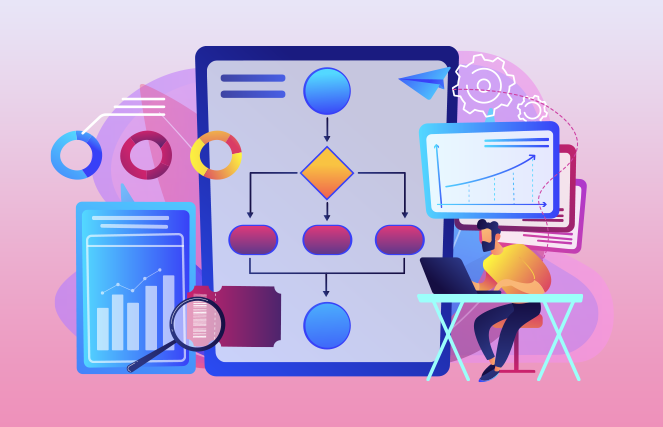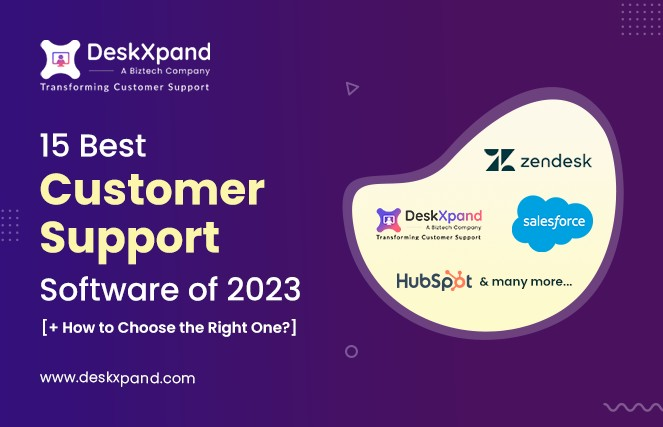The world is changing rapidly, and your organization needs to be agile in order to change with it. It was just 1958 when NASA was born, and the average tenure on the S&P 500 was 61 years. Fast forward to 2023, where NASA’s space agency’s Parker Solar Probe became the first spacecraft to touch the corona of the sun, and the average S&P tenure is forecast to shrink to just 12 years (by 2027.) This means that the organizations that are not able to keep themselves agile to market changes do not seem to survive long.
Did I get your attention? The message couldn’t be clearer: Adapt or die.
The future of tech is more agile, centralized, automated, and integrated than you can imagine. Things that are analog must be digitized. Things that are manual must be automated. Systems that are isolated must be connected. Things that are hidden must be made visible. This applies to everything, including customer support and their workflows. The time is gone when the world revolved around brands. In 2023, everything revolves around the customers.

Next-gen support executives require next-gen tools and ticketing system workflows.

Today, customer support teams are empowered with the latest tech to make more decisions and rely less on hierarchy for control. The latest ticketing systems are robust enough to drive valuable work for everyone involved in the support process. They lead to workflows that are less reactive and more proactive. They help create an interconnected network for agents. And it will require a platform that can seamlessly connect every corner of the enterprise to succeed. At the crux of all this lies one thing: support workflows.
And the paradox about workflows is that it keeps evolving. Paradox? Let me put it this way. Say you designed the perfect workflow solution to help your customers and employees. It enables your team to scale faster and work smarter. Your employees will use these ticketing system workflows to grow and innovate. But at some point in time, your systems will outpace the capacity as your customer needs grow. This, in turn, will push you further to deploy increasingly complex workflows and at an increasingly rapid pace to keep them growing. After a certain point, your employee and customer needs will outpace this ticketing system workflow. Hence, you’ll need to implement new ticketing system workflows. And the paradox continues.
Luckily, in 2023, we have the technology to address this paradox creatively. You can surface this paradox and convert it into opportunities. Workflow ticketing systems can help you implement workflows across the enterprise. In this article, we will talk about workflow ticketing systems and how they help organizations and their support teams evolve continuously.
Need For A Ticketing System Workflow
Ticketing system workflow involves all the steps that your agents need to take in order to successfully achieve a task. A smooth ticketing system workflow will result in increased productivity, collaboration, and delightful customer service.

Customer service is now viewed as strategic.

Most businesses manage their helpdesks manually and get caught up in time-consuming and cumbersome processes. The result? Their teams struggle whenever met with increasing ticket volumes. This leaves the customer with no choice other than to settle with slow responses and problem resolution difficulties. Therefore, you need to optimize your ticketing system workflow to make your support processes more efficient and work like a well-oiled machine. Let’s look at some of the ways to improve the ticketing system workflow.
How To Optimize Ticketing System Workflows

Customer service is the face of brands. More than 80% of businesses rely on customer experience to differentiate themselves from their competitors.

It’s not just after Covid-19 that the companies have suddenly come to this realization. Customers were fed up with phone trees and being passed on from one support executive to another through calls. Customer support can be and should be more effective and empathetic than this.
So, the question goes, how can businesses rise from this challenge? Start with employing a smarter workflow that empowers them to meet customer needs. We’ve already established why workflow management is the single most important thing when it comes to customer support evolution; let’s look at how brands can optimize their ticketing system workflow.
1. Service Level Agreements Based on Real-Time Data
Service level agreements refer to a documented agreement between a brand and its customers that mention the number of services to be provided and its quality. It refers to a collection of promises made by the brands to its customers.
Here’s some insight on how SLAs can be useful:
- Establishes a realistic turnaround time to resolve customer complaints.
- Describes the role of various support executives.
- Explains how queries are captured and distributed among agents.
- Defines parameters for ticket distribution.
- States communication protocols for severe incidents.
Creating strong yet realistic SLAs is not enough. You must encourage your support staff to fulfill the set SLAs for a smooth ticketing system workflow. When it comes to SLAs, it is important that:
- They are realistic and achievable
- They are backed by real-time data and analytics
- Your support executives can practice it while handling customer requests
- They don’t overpromise and under-deliver
Think about it. For instance, if you promise your customers that their issue will be resolved in an hour. And then, your team doesn’t get back to them for days or worse, weeks. Besides, it might set wrong expectations for the customers for the future.
Revolutionize Your Internal Processes
A customized ticketing system ensures smarter workflow processes. From email templates to labels, you can personalize DeskXpand and meet your unique business needs. Explore customization possibilities with DeskXpand. Check out our helpdesk features to optimize your ticketing system workflow.
2. Automation: The Future Of Workflow

A study states that 40% of IT decision-makers foresee automation as something that’ll have the biggest impact on their businesses.

Gone are the days when your agents used to manually pick up support tickets for themselves. They don’t need to manually type emails asking for feedback from the customers anymore. This is for obvious reasons. Manual processes bring inconsistencies and can take the edge off your productivity. OTOH, an automated ticketing system workflow, can help your team achieve more in a time-crunched environment.
Here are some automation capabilities that you can implement for your ticketing system workflow:
- Automate the ticket assignment process
- Share emails automatically for feedback or query rating
- Set automated emails and notifications
- Prepare a ticket escalation structure
3. Design a Real-Time Escalation Matrix
Customer service is a team effort. So when some agents are not able to resolve an issue or are not available, you need to aid them by jumping in and backing them up. This is exactly the reason you need a thorough escalation structure.
There are two types of escalations:
1. Functional: Where tickets need to be escalated due to the lack of knowledge or skills.
2. Hierarchical: Where tickets demand managerial attention or need their approval.
Escalations sometimes become inevitable. Therefore the end goal should be to carry them as swiftly as possible. Here are some tips on how you can improve your ticket escalation processes:
- Train your support executives to improve their skills and help them fill the knowledge gaps.
- Make sure that you’re resolving the tickets that have already been escalated. You can also automate this process.
- Ensure that your ticket routing processes are working fine. Route your tickets to the appropriate support executive from the beginning itself. It can reduce escalations upto a certain extent.
- Evaluate your escalated tickets. See if it’s frequently happening. See if you can avoid the same in the future.
- Encourage consistent communication among different tiers of your customer support team.
- Do a root cause analysis of every escalation and try to optimize your processes accordingly.
4. Create & Update Your Internal Knowledge Base
Every business has an ample number of workflows and processes that everyone in the company should and must know. This is also true for customer support executives. In the light of so much information, support agents might sometimes feel stuck when they come across a new customer issue. They might face trouble looking for the right answers at the right time.
Due to this, training an agent on the nitty-gritty of every single process becomes extremely important. But you cannot have a one-to-one interaction and make sure that everyone is on board all the time. As a solution, you can opt for an internal knowledge base so that your employees can always be closer to the right answers and access them whenever they need them.
Here are some things that’ll help you create a better knowledge base:
- Make it simple to find articles and guides by implementing filters and categorization.
- Keep auditing your knowledge base content on a regular basis.
- Conduct training sessions on how to use the knowledge base.
- Take feedback from the ones who read it. Ask them what should be included and what must be avoided.
- Ask if your employees face any challenges while accessing the knowledge base and work towards annihilating these challenges.
- Make sure these articles are easily shareable from one employee to another.
These knowledge management practices can help you speed up your ticketing system workflow and ensure that support executives are well equipped to offer memorable customer experiences.
5. Track Trends by Implementing Predictive Analytics
Predictive analytics is an advanced trend that can help you optimize your ticketing system workflow. Due to an abundance of data in the company workflow, support executives do not always have the time to go through data and pull relevant insights that can push them to make proactive decisions. An integrated analytics feature (with your helpdesk) can help you track trends. This is beneficial for multiple reasons:
- First, it tracks frequent issues and roadblocks.
- Second, it brings out the issues from the core and helps you address the problem even before the issue actually arises.
- Third, and the most important thing is that it makes informed recommendations that save time and identify important trends that you otherwise would not have recognized.
6. Organize Your Ticketing Processes: Best Practices
To ensure an efficient change in your ticketing system workflows, you need to adhere to the following best practices:
1. Set Ticket Priorities
Support executives can prioritize tickets as ‘High,’ ‘Low,’ or ‘Normal’ based on their urgency. You can set the default priority for any support ticket as ‘Normal.’
2. Add Labels
Use labels to separate important tickets. You can also group similar tickets by using the same label. For instance, if several people have encountered a similar login issue, such tickets can be labeled as ‘login bug issue.’
3. Ticket Merging With Parent-Child Hierarchies
Let your agents merge multiple tickets with similar queries. Once you do that, your tickets will be sorted chronologically, and the first ticket becomes the primary ticket, and the rest of the tickets become secondary tickets.
4. Add Attachments & Notes
Let your executives add attachments for internal communication while responding to a ticket. Other than this, enable them to send documents, sheets, images, knowledge base articles, etc., to the customer.
Achieve More With a Solid Help Desk Workflow
In order to ensure that your helpdesk processes, tools, and employees operate at peak efficiency, you need to create and follow a full-proof helpdesk workflow. You can do this by creating an internal knowledge base and encouraging knowledge sharing among your service agents. To improve your ticketing system workflow, set realistic service level agreements, and automate manual processes.
Build a customer-oriented workflow with DeskXpand. DeskXpand helpdesk enables businesses to:
- Provide quick resolutions
- Simplify business services
- Reduce glitches
- And eventually, cultivate a customer-oriented culture
DeskXpand is a fully automated, omnichannel service that caters to all types of businesses (from small to large.) We are an ISO27001 certified development company with 15+ years of development experience. Work with us to bring your customer goals to reality. Find out more about DeskXpand.







